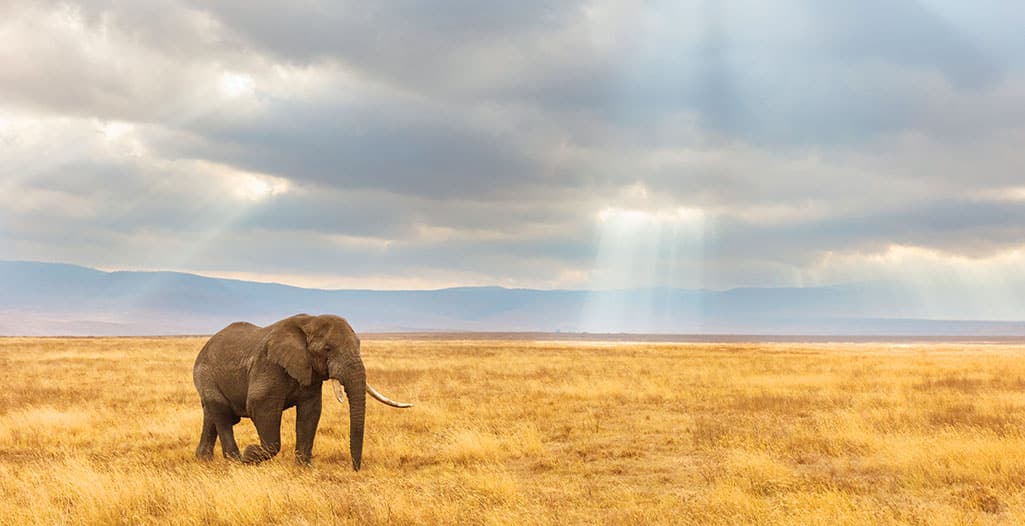Flight crews are trained to be ready for anything. “Anything” can run the gamut from mechanical problems to in-flight medical emergencies to extreme weather. As many aviation operations and insurers have learned, that list should include animal encounters.
Below are details of actual incidents that led to some priceless stories.

How Does an Elephant Scratch an Itch?
A Beechcraft King Air was parked outside on an African game reserve. When the pilot returned in the morning, he found damage to the fuselage skin and left wing.
What could have caused such damage? With a bit of detective work, it was determined that a large animal—likely an elephant—had rubbed against the aircraft. People familiar with elephant behavior speculated that the huge animal had used the plane as a “scratching post.” When you’re that big and have an itch you can’t reach, you’ve got to get creative!
Lesson learned: Avoid leaving aircraft outside at night if you can—especially if there are large beasts about.
No Bull
Another encounter with a sizable—and this time, angry—animal occurred at a ranch in Mexico. A CJ3 had just landed at the property, and the pilot and passengers were exiting the aircraft.
Imagine their surprise when they saw a bull charging at them. Or, more accurately, at the plane.
The belligerent bovine attacked the aircraft, puncturing a wing and flaps and causing over USD$100,000 in damages. If there’s a silver lining, it’s that he patiently waited for the plane to park before launching his assault.
Scorpions on a Plane!
Scorpions are native to many parts of the world. However, you don’t typically find them at 30,000 feet.
A passenger experienced bites on his neck and back. When he deplaned, went to a restroom and removed his shirt, he saw a scorpion fall to the floor. He believed it had been in an overhead baggage compartment and had “boarded” him when he retrieved his bag.
Although there was no way to determine whether the creature had been in the compartment or had come onto the aircraft in the man’s baggage or clothing, the airline paid for his medical treatment. And everyone who learned of the incident will forever take a closer look at their bags and check their pockets before boarding a plane!
Deer in the Landing Lights
Our insured operates a Gulfstream G650 for Part 91 purposes. After a short flight to a regional airport in the Southeastern United States, they were surprised to learn they had had an undetected animal encounter.
As ground crews towed the aircraft into the hangar, they discovered an antler lodged in a flap. The pilots hadn’t seen or felt anything as they landed, and no other evidence of a deer was found on the aircraft or the runway. But somewhere that day was an animal with a serious headache.
Bees Begone
Our insured’s Gulfstream G200 encountered cooling issues, which the crew identified over a few trips. Further inspection by maintenance technicians identified damage to the cockpit and cabin environmental system.
The cause? Not wear and tear or a broken component. Thousands of bees had colonized the aircraft heat exchange/refrigeration unit in the rear of the aircraft. And that housing decision had a hefty price tag. The resulting heat damage led to a claim of approximately USD$1 million.
The High Cost of a Meal
An incident that had an unfortunate physical and financial ending occurred on an autumn day. A chipmunk was doing whatever it is that chipmunks do when a red-tailed hawk unexpectedly nabbed him. Snack time! However, a fellow hawk coveted this prize, and a battle was on.
The aerial dogfight drifted onto the grounds of a major airport. As the battle raged five feet above a runway, the chipmunk and both hawks were unceremoniously ingested into an engine affixed to a widebody commercial jet that had just landed.
The aircraft was using its reverse thrusters—an operation that takes place at full engine power. Needless to say, the trio met an unpleasant demise.
The encounter was similarly unfortunate for the aircraft’s engine. All fan blades and the fan case were destroyed. Fan blade fragments subsequently damaged the nose cowl and thrust reverser cascades. The impact also damaged the compressor section, and the blades sustained tip-rub in the turbine section from severe vibration due to imbalance and, ultimately, engine seizure.
What’s more, the flying debris damaged the fan blades and nose cowl on the opposite engine and various parts of the airframe. The resulting claim cost more than USD$5 million.
The morals of the story…
Chipmunks: Keep an eye on the skies.
Red-tailed hawks: Never let hunger affect your situational awareness.
Claims adjusters: Note that ingesting wayward wildlife can be very expensive.